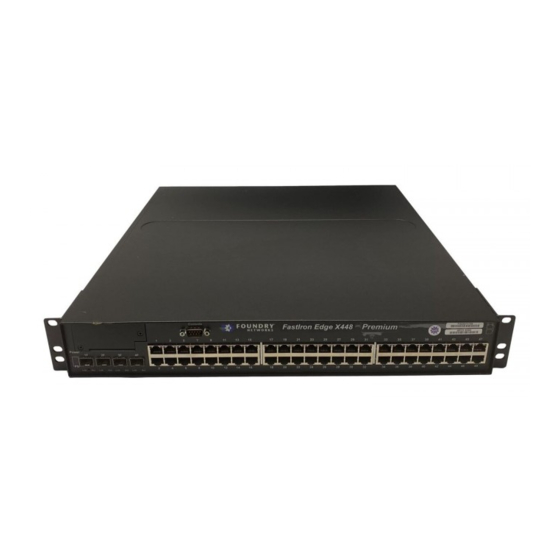
Brocade Communications Systems FastIron Manuals
Manuals and User Guides for Brocade Communications Systems FastIron. We have 1 Brocade Communications Systems FastIron manual available for free PDF download: Administration Manual
Brocade Communications Systems FastIron Administration Manual (388 pages)
Ethernet Switch
Brand: Brocade Communications Systems
|
Category: Switch
|
Size: 2 MB
Table of Contents
-
Preface
11 -
-
-
-
Limitations37
-
NTP and SNTP38
-
NTP Server38
-
NTP Client39
-
NTP Peer39
-
VLAN and NTP43
-
-
-
-
OAM Overview89
-
-
-
-
Commands137
-
-
Ipv6
139 -
SNMP Access
147-
SNMP Overview147
-
-
Trap MIB Changes157
-
-
-
LLDP Overview174
-
Benefits of LLDP174
-
-
-
LLDP-MED Class176
-
-
LLDP Packets178
-
TLV Support178
-
MIB Support182
-
Syslog Messages182
-
-
-
Port Description191
-
-
-
-
-
RMON Support240
-
Sflow245
-
Sflow Version 5245
-
-
-
-
-
Sysmon Ecc-Error268
-
-
-
Sysmon Fa Link272
-
Syslog
285 -
Syslog Messages
297 -
-
-
Power Class342
-
-
Openssl License
385 -
-
JITC Overview387
-
Advertisement
Advertisement
Related Products
- Brocade Communications Systems FastIron CX
- Brocade Communications Systems FastIron SuperX
- Brocade Communications Systems FastIron X Series
- Brocade Communications Systems FastIron SX Series
- Brocade Communications Systems FastIron FCX Series
- Brocade Communications Systems FastIron ICX Series
- Brocade Communications Systems FastIron GS
- Brocade Communications Systems FastIron GS-STK
- Brocade Communications Systems FastIron CX Series
- Brocade Communications Systems FastIron CX 624S-HPOE
